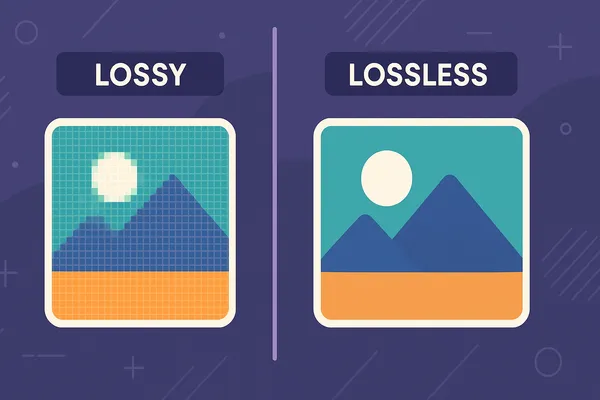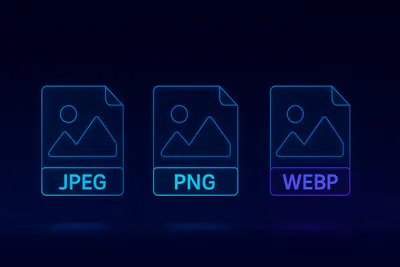Lossy vs Lossless Compression: What's the Difference?
2025-03-25
- → Introduction
- → Understanding Data Compression
- → What is Lossless Compression?
- → What is Lossy Compression?
- → Comparing Lossy and Lossless Compression
- → Real-Life Examples and Applications
- → How to Choose Between Lossy and Lossless Compression
- → FAQ
- → Conclusion
- → References
Introduction

Data compression is a cornerstone of modern computing, enabling efficient storage and faster transmission of digital information. It reduces file sizes by encoding data more compactly, which is crucial in a world where storage and bandwidth are finite resources. Compression methods are broadly divided into two categories: lossy and lossless. This article explores these two types, highlighting their differences, use cases, benefits, and drawbacks.
Understanding Data Compression
Data compression refers to the process of encoding information using fewer bits than its original representation. The need for compression arises from the desire to save storage space, reduce transmission times, and optimize bandwidth usage .
However, compression involves trade-offs:
- Compression Ratio: Higher ratios save more space but may affect quality.
- Data Fidelity: Some methods sacrifice data accuracy for efficiency (as in lossy compression), while others retain perfect fidelity (as in lossless compression) .
What is Lossless Compression?
Lossless compression ensures that data can be compressed and then decompressed back to its exact original form without any loss of information. This method is ideal for applications where data integrity is critical.
Examples of Lossless Algorithms and Formats:
- ZIP and GZIP for general-purpose files.
- PNG for images.
- FLAC for audio .
Typical Use Cases:
- Archiving sensitive data (e.g., medical images, legal documents).
- Text files or executable programs where accuracy is paramount .
Benefits:
- Perfect reconstruction of original data.
- Essential for applications requiring high precision .
Drawbacks:
- Lower compression ratios compared to lossy methods.
- Larger file sizes may result in higher storage and bandwidth requirements .
What is Lossy Compression?
Lossy compression reduces file size by discarding less critical data, leading to irreversible quality loss. It achieves significantly higher compression ratios compared to lossless methods.
Examples of Lossy Algorithms and Formats:
- JPEG for images.
- MP3 for audio.
- MPEG or H.264 for video .
Typical Use Cases:
- Streaming media (e.g., music and video streaming platforms).
- Web images optimized for faster loading times.
- Video conferencing where real-time transmission matters more than perfect quality .
Benefits:
- High compression ratios save substantial storage space and bandwidth.
- Enables faster data transmission, especially over limited networks .
Drawbacks:
- Irreversible loss of some original quality or details.
- Not suitable for applications requiring exact data reproduction .
Comparing Lossy and Lossless Compression
| Feature | Lossy Compression | Lossless Compression |
|---|---|---|
| Methodology | Discards less critical data | Preserves all original data |
| Compression Ratio | High | Moderate |
| Quality Retention | Degraded (irreversible) | Perfect retention |
| Use Cases | Streaming, web content | Archiving, medical imaging |
| Examples | JPEG, MP3, MPEG | ZIP, PNG, FLAC |
In general:
- Choose lossless compression for archival purposes or when preserving every detail is crucial.
- Opt for lossy compression when storage or bandwidth efficiency outweighs the need for perfect fidelity .
Real-Life Examples and Applications
-
Lossy Compression Applications:
- Music streaming services like Spotify use MP3 or AAC formats to reduce file size while maintaining acceptable audio quality.
- Video streaming platforms such as Netflix employ MPEG formats to deliver high-quality video with minimal bandwidth usage .
-
Lossless Compression Applications:
- FLAC is used by audiophiles to store high-quality audio without any degradation.
- PNG is preferred for digital artwork or images that require editing because it retains all details .
-
Hybrid Formats Offering Both Options:
- TIFF files can be compressed either losslessly or lossily depending on user needs.
- WebP supports both modes to balance quality and size efficiently .
How to Choose Between Lossy and Lossless Compression
Consider the following guidelines when deciding between lossy and lossless compression:
-
Nature of Data:
- Use lossless if preserving all details is essential (e.g., legal documents).
- Use lossy if some quality loss is acceptable (e.g., streaming media) .
-
End-User Needs and Bandwidth Limitations:
- For users with limited storage or bandwidth, lossy formats are more practical.
- For professional use cases like medical imaging or archival purposes, lossless formats are mandatory .
-
Future Editing Requirements:
- Lossless formats allow re-editing without degradation.
- Avoid lossy formats if further editing might be needed .
FAQ
- What is the difference between lossy and lossless compression? Lossy compression reduces file size by discarding less critical data, leading to some quality loss, while lossless compression preserves all original data and allows for perfect reconstruction.
- When should I use lossless compression? Use lossless compression when preserving data integrity is crucial, such as for medical imaging, legal documents, or archival purposes.
- What are the benefits of lossy compression? Lossy compression offers higher compression ratios, saving significant storage space and bandwidth, making it ideal for streaming media and web content.
- Which formats use lossless compression? Common lossless formats include ZIP, PNG, and FLAC, typically used for archiving, digital artwork, and high-quality audio.
- What are examples of lossy compression formats? Popular lossy formats include JPEG for images, MP3 for audio, and MPEG for video, often used in streaming services and web optimization.
- Can I edit files compressed with lossy methods? Editing lossy-compressed files is not recommended, as each re-compression cycle leads to further quality degradation. For editing, use lossless formats instead.
- How do I choose between lossy and lossless compression? Consider the nature of the data, end-user needs, bandwidth limitations, and future editing requirements to decide whether to prioritize efficiency (lossy) or fidelity (lossless).
Conclusion
Lossy and lossless compression serve distinct purposes in the digital world. While lossy methods prioritize efficiency and smaller file sizes at the expense of some quality, lossless techniques ensure perfect fidelity at the cost of larger file sizes. Understanding these differences helps users make informed decisions based on their specific needs.
As technology evolves, hybrid techniques combining the best aspects of both approaches are emerging, promising even greater flexibility in managing digital content efficiently.
References
- [1] What is Data Compression & What Are The Benefits | Barracuda Networks
- [2] Data Compression Techniques in Modern Computing | Siberoloji
- [3] Lossless Compression: Advantages, Disadvantages, & Types | Seahawk
- [4] Lossy compression - MDN Web Docs Glossary: Definitions of Web-related terms | MDN
- [5] A Guide to Lossy vs Lossless Compression | NinjaOne
- [6] Lossy compression - Wikipedia
- [7] Understanding Lossless Image Compression | Cloudinary
- [8] 5 Key Differences Between Lossless and Lossy Compression

